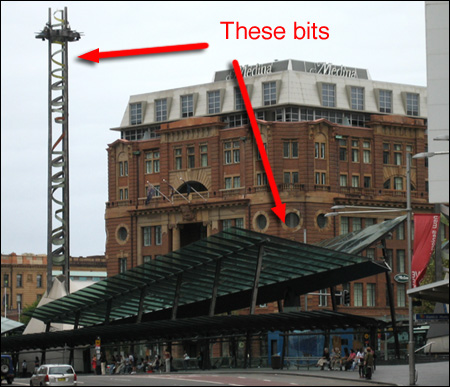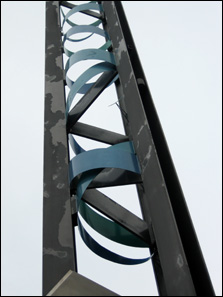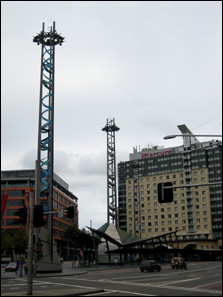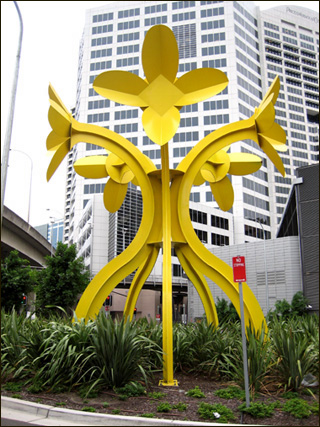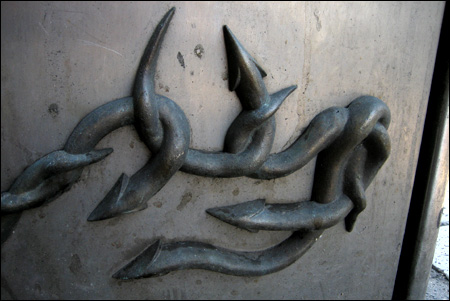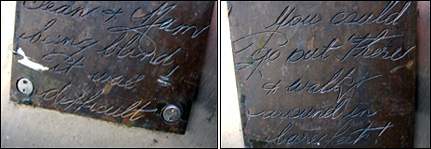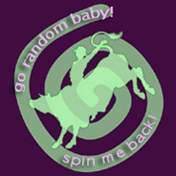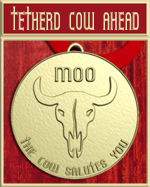Thu 6 Sep 2007
Red Poles
Posted by anaglyph under Bad Sydney Art
[16] Comments
Well Acowlytes, this is likely to be our last stop on the Bad Public Art Tour of Sydney, not because I’ve even come close to running out of Bad Art, but because, as I mentioned last post, I’m about to wave goodbye to The Harbour City and take up residence in The Paris of the South where the public art is of a different calibre altogether.
Today we head out west of Sydney toward the Blue Mountains. Have your cameras at the ready, because we’re on the freeway and will be (thankfully) passing this lame effort at speed.
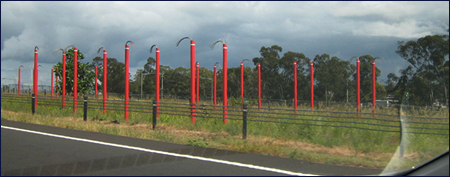
I used to drive past these red poles on my weekly trips to the Treehouse. For months I’d sail on by thinking ‘When are they going to finish those damn things?’.
The poles, painted in garish Road Safety Orange with wires sticking out the top, were obviously some kind of lighting fixtures awaiting a tardy electrician to turn up and complete the job. One day as I sped past the thought entered my head that… ‘Oooooo… they are finished. It’s some kind of artwork!’
And then, chuckling to myself at my silliness… ‘N-o-o-o-o… that couldn’t be right…’
But it was. This is the Light Horse Interchange Sculpture Parade and those poles that look so much like a bunch of safety barricades on a bad hair day are in fact supposed to be symbolic of the horses and men of the Australian Light Horse regiments that served in France and The Middle East in the First World War.
This is how the effort is described on the Westlink M7 website:
Red, the colour of the Flanders poppy and poppies that bloomed throughout Palestine, is symbolic of the blood of supreme sacrifice and is the colour chosen for the sculptural group. The abstract plumage attached to each marker represents the emu plumes attached to the Light Horsemen’s slouch hats. The white band is a reference to the departing soldiers’ innocence of war.
Got that? Let me just rephrase it to clarify:
Crap. Crap. Crap crap crap crap crap crap crap crap crap crap crap crap crap crap crap crap crap crap crap crap crap crap crap crap crap crap crap crap. Crap.
First of all, the colour of the poles is not like any kind of blood I’ve ever seen, though at a stretch I guess you could say there are poppies that colour. Orange poppies. Secondly, the sculptor, whose identity I cannot find anywhere on the web (for obvious reasons, one has to speculate…) has evidently never seen an emu feather because they don’t look anything like bits of electrical wire. And aside from anything at else, the whole effect is just so completely pathetic. There’s no feeling of skill, or deliberation, or elegance, or challenge, or illumination, nor indeed any measure of art at all.
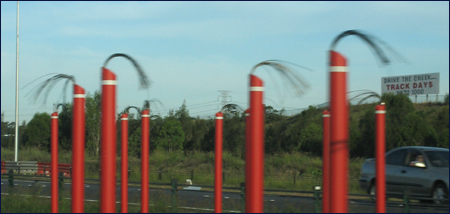
I have a terrible sinking feeling, in fact, that there was no actual decent artist within cooee of this project, but that the bunch that designed the freeway – engineers from the Urban Planning Department of the Roads and Traffic Authority and urban design company Conybeare Morrison – appended a quick sketch for the ‘sculpture’ to the bottom of one of their blueprints for the engineering of the overpass construction.
It would help explain the appalling ‘artistic’ statement that I quoted above. It certainly wasn’t penned by anyone with artistic thoughtfulness because it’s so awful.
In a review in Architecture Australia, General Manager of the New South Wales Government Architects Office, Peter Mould, says of the work:
This is a strong theme for public art, but its execution is disappointing. It is artwork seen in passing, at speed, and calls for a robust scale so that the rhythm of the parade is legible. The feathers, too, are unconvincing.
And that, for me, says it all. It doesn’t even meet the standards of a Government architect.
___________________________________________________________________________
Thanks Alicia for Pic#1 and Violet Towne for Pic#2
___________________________________________________________________________
